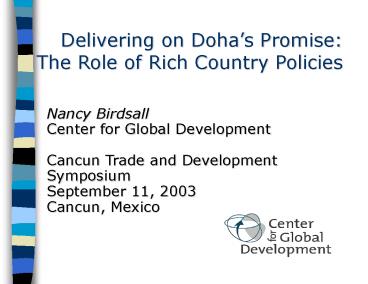Delivering on Doha - PowerPoint PPT Presentation
1 / 19
Title:
Delivering on Doha
Description:
Delivering on Doha s Promise: The Role of Rich Country Policies Nancy Birdsall Center for Global Development Cancun Trade and Development Symposium – PowerPoint PPT presentation
Number of Views:85
Avg rating:3.0/5.0
Title: Delivering on Doha
1
Delivering on Dohas Promise The Role of Rich
Country Policies
Nancy Birdsall Center for Global
Development Cancun Trade and Development
Symposium September 11, 2003 Cancun, Mexico
2
Why a CDI?
- Rich country policies matter for development
- Time to hold rich countries accountable
- Need a tool to measure rich country commitments
to development ex Millennium Development Goal 8
3
What is the CDI ?
- Measure of policy effort on policies that affect
development prospects of poor countries - The index ranks 21 countries members of the DAC
(except Luxembourg)
4
Components
- Aid
- Trade
- Investment
- Environment
- Migration
- Peacekeeping
5
Overall Scores
6
Goals of the CDI
- Educate and inspire to action the rich-world
public and policy makers - Motivate a race to the top among OECD countries
- Spark new research and data collection
- Foster debate about the role of rich country
policies in development
7
Trade
- Aggregate measure of protection in tariff
equivalent terms - Tariffs
- Non-tariff barriers
- Subsidies
- Revealed Openness
8
Total Tariff Equivalent of Agricultural
Protection Against Developing Countries(percent
tariff equivalent)
US Canada EU Japan
Tariffs 11.2 62.6 67.4 202.3
Tariff-Equivalent of domestic subsidies 20.8 1.8 19.6 9.8
Total Tariff-Equivalent 34.3 65.5 100.2 231.9
Source William Cline, An Index of Industrial
Country Trade Policy toward Developing
Countries, CGD Working Paper 14, October 2002.
9
(No Transcript)
10
Trade Results
11
Global Free Trade Can Reduce Poverty in
Developing Countries by
- 1. Opening Agriculture Markets
- 2. Raising Unskilled Labor Wages
- 3. Boosting Productivity
- 4. Inducing Investment
- 5. An early harvest free market access for poor
nations
12
Liberalization of agricultural markets
- Agricultural protection against developing
countries - 34 percent in the United States
- 100 percent in the EU
- 230 percent in Japan
- 65 percent in Canada
- Free trade in agriculture would reduce global
poverty by an estimated 200 million people, or
about 7 percent.
Source William Cline, Trading Up Trade Policy
and Global Poverty, CGD Brief 7, September 2003.
13
The Impact of Global Agricultural Liberalization
on Poverty in Selected Countries
Biggest Reductions in Poverty, () Biggest Reductions in Poverty, (millions)
Malawi (15.2) China (72.1)
Vietnam (15.1) India (59.2)
Kenya (14.8) Bangladesh (12.0)
Tanzania (12.0) Pakistan (10.4)
Bangladesh (11.8) Indonesia (9.9)
Source William Cline, Trading Up Trade Policy
and Global Poverty, CGD Brief 7, September 2003.
14
Raising Unskilled Labor Wages
- Global free trade would boost world income by
about 230 billion annually - About 140 billion in gains for industrial
countries and 90 billion for developing
countries - In developing countries, real wages of unskilled
labor would rise by an estimated 5
Source William Cline, Trading Up Trade Policy
and Global Poverty, CGD Brief 7, September 2003.
15
Boosting Productivity
- Increasing trade spurs productivity, which in
turn supports long-term increases in per capita
income. - Productivity gains in developing countries would
lift an estimated additional 200 million people
out of poverty in the long term.
Source William Cline, Trading Up Trade Policy
and Global Poverty, CGD Brief 7, September 2003.
16
Inducing Investment
- Increased trade opportunities induce investment,
which also generates long-term increases in per
capita income. - Capital investment effects could conservatively
reduce the number living in poverty by an
additional 300 million people.
Source William Cline, Trading Up Trade Policy
and Global Poverty, CGD Brief 7, September 2003.
17
An early harvest free market access for poor
nations
- LDCs, SSA and HIPC countries account for 64
countries with a combined population of 1
billion, of whom 715 million live in poverty. - Estimated growth effects from preferential trade
agreements - US Caribbean Basin Initiative 7-8
- EU Lome-Cotonou arrangement 7-8
- Andean Trade Preference Act 2
Source William Cline, Trading Up Trade Policy
and Global Poverty, CGD Brief 7, September 2003.
18
Poverty Intensity of US Imports from Developing
Countries
Regions Headcount Weighting Income Share Weighting
Total 38.11 8.16
LDC 69.2 44.1
HIPC 66.1 38.7
SSA 70.3 55.8
Source William Cline, Trading Up Trade Policy
and Global Poverty, CGD Brief 7, September 2003.
19
Impact of Global Free Trade on Global Poverty
Reduction (in millions, cumulative)
Source William Cline, Trading Up Trade Policy
and Global Poverty, CGD Brief 7, September 2003.































